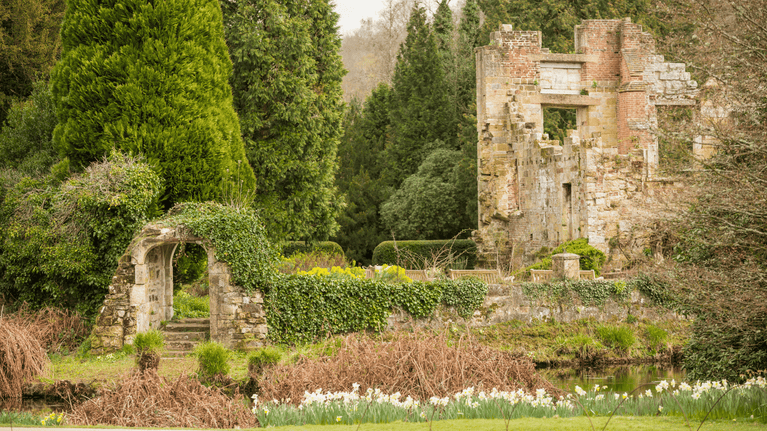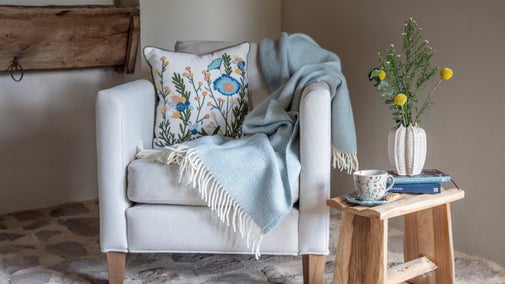
Discover more at Scotney Castle
Find out when Scotney Castle is open, how to get here, the things to see and do and more.

With the garden and estate at Scotney Castle covering more than 780 acres there is plenty to see, from the moated ruined 14th-century castle to the walled garden and Grade I listed parkland. There are wonderful views to take in as you explore the landscape through the different seasons.
The garden was created in the late 1830s at the same time as the house allowing the two to work together to create the perfect country home. The then owner, Edward Hussey III, had the vision to transform medieval Scotney Castle from a damp and derelict dwelling into a charming ruin that would become the centrepiece of his romantic and naturalistic landscape. Working with architect, Anthony Salvin and landscape designer, William Sawrey Gilpin, Scotney Castle represents one of the last and most successful expressions of the Picturesque movement.
The view from the semi-circular Bastion above the Quarry Garden to the moated castle ruin is breath-taking in all seasons, whether it is bare frost-covered branches and mist rising from the moat in winter, the colourful azaleas, rhododendrons and kalmia in spring and summer, or the flaming reds and oranges of the acers in the autumn.
In summer, the old English roses clambering up the walls of the Old Castle and the surrounding herbaceous beds provide picture-perfect backdrops. The grass terraces around the house are deliberately left long to protect and encourage the rare green-winged orchids that flower there in spring. This plant was in decline after the Second World War but, thanks to this management approach, they now thrive in these lawns alongside many other species of wildflower.
Wandering through the garden you will also discover the quarry garden, the ice house thatched with heather, the Victorian boat house on the moat and the old bowling green as well as the chalybeate spring, acres of wild meadows, giant sequoias, and the stream that feeds the castle moat. You will also find the Badger and Pepper play area for younger children.
Before you leave Scotney, be sure to visit the peaceful one-acre walled garden. Built around 1840 to provide the Hussey household with fresh fruit and vegetables, its unusual octagonal shape maximises the amount of growing space for the fan-trained and espaliered fruit trees. Varieties of apricot, peach, cherry, plum, greengage, apple, quince and pear growing here. Other features of note are the original watering-can dipping pond and, in the far left corner, a huge and ancient crab apple tree which is covered in white blossom in spring.

Spring creeps in cautiously at Scotney with the early snowdrops braving the cold February and March winds, but before long they are joined by an array of dancing daffodils across the garden, pale clusters of primroses and stunning chequered snake's head fritillaries. The camellia and magnolia blossom too appear early in the season providing welcome colour and the promise that better weather must be on its way.
Look out for drifts of wild daffodils under the trees and on the boathouse flat and the little Narcissus bulbocodium ('Hoop Petticoat' daffodil) growing on the lower castle walls. You will find the beautiful white, Narcissus ‘Thalia’ in the conifer bed at the top of the garden alongside the yellow blooms of the wild and native Tulipa sylvestris, both are fragrant and perfect for naturalising. We also have an ancient variety, first recorded in the 1600s, Narcissus ‘Eystettensis’, a lovely double cultivar, which you will see in the West Glade near the Redwoods.
Each week brings fresh blooms and new colours to the spring palette. The main blossom waits for longer, slightly warmer days. In the walled garden it is the peach and plum enjoying the heat from the aged brick walls that are the first to open their tightly-curled buds, followed by the pear, cherry and apple. Later in spring the old malus, or crab apple tree, in the corner of the walled garden, stands bedecked in white blossom like a towering bride. In the main garden, follow the billows of pale blossom of the amelanchiers and the flowering cherries and crab apples that arch overhead.
For many, the highlight of late spring are the carpets of bluebells you will find in the sheltered areas of the garden and in certain areas of the ancient woodland on the Scotney estate. Ask a member of staff to direct you to the best displays. In the language of flowers, the bluebell is a symbol of humility, constancy, gratitude and everlasting love, and it is said that if you turn a bluebell flower inside-out without tearing it, you will win the one you love. Beautiful but fragile, it takes five years for a bluebell seed to grow to a bulb that will flower, and they are very sensitive to being crushed by human and canine feet so please stick to the paths when you're out and about. Folk stories also say that if you pick a bluebell you will be led astray by fairies, wandering lost forevermore, so, enjoy the sight and smell but don't pick them - just in case.
Another favourite for spring and early summer are the azaleas and rhododendrons for which Scotney is renowned. The first azaleas come out as early as the end of February, but the main show is from late March to late May when waves of purple, pink and pastel rhododendrons cover the main lawns and edge the footpaths that wind to and from the heather-thatched ice house The best place to see the brilliantly-coloured azaleas is from the Bastion viewpoint or in the quarry garden where you'll also be able to enjoy the rich perfume of the Ghent azaleas. Look out too for the Judas trees (Cercis siliquastrum) - with unusual and profuse pink blossom on bare wood, they're hard to miss.
The Scotney Castle estate has a long and varied history and the ancient parkland and Wealden woodlands surrounding the house and garden are criss-crossed by waymarked routes, offering fantastic views of the castle, garden and house.
Grade I listed, the parkland is full of magnificent veteran trees inlcuding what is believed to be the oldest hornbeam tree in the country, showing its association with a formal dwelling for over 1,000 years. The woodlands are characteristic of the Wealden landscape and cover 300 acres of the estate; they boast connections with wood-pasture, charcoal production, iron working and the once-lucrative hop industry.
Scotney is the only National Trust property to have a working hop farm and the tenant farmer at Little Scotney Farm still grows, picks and dries hops which are then used by a local brewery to make craft beers, some of which you can buy in the Scotney shop.
The native-breed Sussex cattle have been a proud feature of the landscape since Victorian times. Our archives show handwriten records of the first herd of Sussex cattle being acquired in 1896. Click the button below to read how we have reintroduced cattle to the estate for conservation grazing.

Between March and early November you can join one of our estate guides on a tour around the estate to see seasonal flora and fauna and learn about the history of Scotney.
These guided estate walks are scheduled to run seven days a week, twice a day at 11.30am and 2pm and last around 90 minute. They are led by our volunteer guides and occasionally we do have to cancel a walk due to absence. This can sometimes be at short notice. If you are planning to visit Scotney specifically for the guided estate walk we suggest you call us on 01892 893820 before you set off on the day to confirm.

Much of the garden has accessible all-weather paths and, with 780 acres of wider estate, there's lots of space for little legs to run, cllmb, explore and let off steam. Look out for the giant tree swing by the new orchard.
For den-making and wild play head to Colliers Wood or, for younger children, the Badger and Pepper play area has musical instruments, a toddler swing, play hut, ball chute and mud kitchen.
There are buggy-accessible toilets and changing facilities in the Courtyard and children's lunch boxes are available in the tea-room.
See how many of your '50 things' you can tick off, or check the Scotney What's On boards or web pages to find details of additional events and activities for families and children.
Picnic blankets are welcome in the garden, however chairs and tables can only be used on the wider estate. If you enjoy a picnic on the estate please be aware livestock may be present. Dogs must be kept on a lead at all times and please take all your litter home with you. (There are rubbish bins in the tea-room courtyard if you need them.)

Find out when Scotney Castle is open, how to get here, the things to see and do and more.

Discover how we're working with Kent Wildlife Trust to help manage the grassland on part of the Scotney estate.

Whether you're enjoying a walk through the estate together, soaking up the beauty of the formal garden or popping in for a cuppa, here's everything you need to know about bringing your dog to Scotney Castle, a 3 paw print National Trust place.

From secret doors to ornate furniture and amazing collections of art, costume, books and silverware, find out about the house at Scotney Castle and how the Hussey family made it a home.

Discover our glorious spring/summer range in our main Courtyard shop. Pick up a perfect new accessory for yourself or your home - from gorgeous garden goods and wonderful printed scarves to embroidered cushions and beautiful ceramics. And do pop into the second-hand bookshop by the Visitor Entrance before you leave to discover some bargain recycled reads.

There's nothing better than a warm spring day: fresh air, sunshine and food enjoyed in the outdoors. Whether you're going for the full lunch option or just a snack to keep you going 'til tea, there's a full range of savouries and bakes to entice you. And if the English weather doesn't play ball there'll always be jacket potatoes and fish finger sandwiches ...

From 18th-century water gardens and Arts and Crafts landscapes to intimate woodland gardens, there are so many places to discover.

Discover our gardeners’ top tips so you can make the most of your garden, plot or window box.

There are spring gardens aplenty to explore in Kent, including Sissinghurst – one of the most famous in the country. From productive walled gardens to beautiful blooming borders, there's something for every taste and a range of events to match.